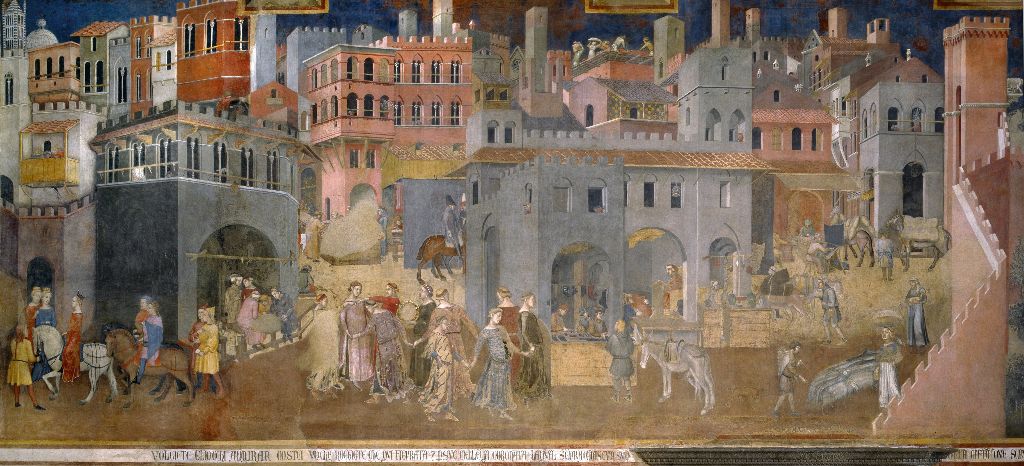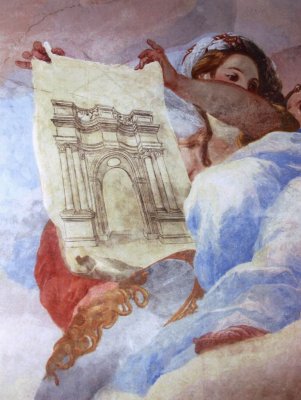International Conference 'HEREDITAS URBIUM': THE INHERITABLE CITY
HEREDITAS URBIUM: THE INHERITABLE CITY
Concrete examples of a true urban regeneration
International Conference
Scuderie Aldobrandini - Villa Falconieri
Frascati
5th-8th June, 2025

Ambrogio Lorenzetti, Allegory of the good government in the city, 1339, Palazzo pubblico, Siena.
The humanist tradition, which has been thrown into crisis by the primacy of the economy and the myth of infinite growth, needs to be revived today as the only means of salvation for our culture, which is enslaved by consumerism. Even classical architecture is a language that has been abandoned or mothballed and could rightly be placed alongside the classical languages, with a view to its reintegration in the wake of authentic modernity. There is a desperate need for a “return to beauty”, to be pursued with great courage and non-conformism. - Paolo Portoghesi
Οἶµαι ἡµῖν τὴν πόλιν, εἴπερ ὀρθῶς γε ᾤκισται, τέλεως ἀγαθὴν εἶναι... Δῆλον δὴ ὅτι σοφή τ'ἐστὶ καὶ ἀνδρεία καὶ σώφρων καὶ δικαία.
“I believe that our City, if it is well built, will also be perfect. ...And then it certainly will also be wise, courageous, temperate and just.” - Plato, Republic, IV,427eEt filii filiorum et semen illorum habitabunt in saecula
“And the sons of the sons and their offspring will dwell there for centuries” - Inscription on the frieze of Palazzo Canossa in Verona.
The dominant trends in modern and contemporary architecture seem to have forgotten the importance of people's ties to different territories, historical places, and traditions. Nonetheless, for more than thirty years, in parallel with the common practice of “designing for any place”, a number of architects and town planners have created works of great aesthetic, social, environmental and economic value, in order to respond to the sense of identity and belonging which lies at the base of human living.
The recent incentives of the European Community and local governments to revitalise the building sector, as well as laws on urban regeneration, unintentionally risk damaging territorial heritage, rather than protecting it, enhancing it and, as a result, improving the economy, cities and the environment. In fact, since the real estate market is unprofitable in new and anonymous urban districts, the interests of those operating in the sector are increasingly turning to historically characterised urban realities.
Yet, at a time when the UN conferences on climate change impose deadlines for energy efficiency (think of the outcomes of COP 26, 27 and 28), rather than allowing the demolition and replacement of solid historic edifices, one should intervene on hastily and unscrupulously erected post-war constructions. In fact, as the native Americans teach, every building should be planned for “the seventh generation”: this was certainly the case for historic buildings, but not for those which sprang up after the war.
In this sense, with the aim of changing the ways of designing cities and mobility therein, a number of institutes have set up study programmes in Italy to allow their students to get to know our urban centres at first-hand, understanding their development, uniqueness and dynamics, and eventually return to creating sustainable buildings (and lives). In fact, it is necessary to learn anew a method of reading places and their distinctive characteristics, in order to operate with respect for the territories and those who inhabit them, while adapting different design solutions to the needs of the XXI century.
Every place is characterised by modes of use, present and past, and transformation processes that new architectural and urban planning interventions must take into account, overcoming self-referential ambitions that tend to separate functional and physical areas. Therefore, any “urban regeneration” requires a holistic (re)vision of the city, as well as an action that is sensitive to the needs of all citizens, and attentive to social, economic, anthropological, environmental and historical aspects. Without an organic vision of the roots and contexts of each place, we would end up leading our heritage to disappear and countries to be no different from others, thus undermining, as a side-effect, tourist flows and the national economy.
Unfortunately, those who dare to look over their shoulders are often accused of retrograde, die-hard nostalgia. To this, one could respond paraphrasing Maria Ponti Pasolini’s warning of 1915: “in Italy, more than elsewhere, we believe ourselves to be hindered by tradition, which, however glorious, weighs on many like a leaden cloak. But tradition may be, as Manzoni said of error, an obstacle against which the blind stumble, but for those who care to lift their foot it becomes a step to attain greater heights”. (Maria Ponti Pasolini, Il Giardino Italiano, E. Loescher & Co., Roma, 1915, pag. 4.)
Thanks to the correct analysis of places, and to the recovery in Italy of those instruments cancelled by the laws of 1925-26, today we would have the possibility of favouring the reconsolidation of our cities and the improvement of living conditions in the suburbs. We would also put an end to soil consumption, restore land to the countryside, improve climatic conditions, and create public profit - rather than an increase in debt.
This conference, organized by the Accademia Vivarium novum, intends to demonstrate the feasibility of such a city. We are therefore addressing not only architects and urban planners, but above all trade associations, builders, real estate developers, professionals, politicians, and citizens, exemplifying our advocacy with towns that have already been built and that will be illustrated directly by the individuals who designed them and permitted their construction. Our goal is to redirect programs of urban planning and current regulations in the name of a future to be left to posterity.
We therefore propose urban operation designed for the seventh generation, one which our children and grandchildren can benefit from, rather than pay the bill - an operation that, in a word, we could define as "heritable".
“People are happy in cities which are beautiful.” - Elio Vittorini, The cities of the world
“Unnatural metropolitan concentrations do not fill any void, rather they accentuate it. A man living in cages built of concrete, in crowded hives, in asphyxiating barracks, is a man condemned to solitude.” - Eugenio Montale
How to participate

In person: reservation required by writing to convegni@vivariumnovum.net.
Virtually: it will be possible to register on the Zoom platform to follow the conference remotely, through this link: https://us06web.zoom.us/webinar/register/WN_e8-b7HgfS3m2y1wlYiFG6A#/registration.
A simultaneous translation into English will be available both remotely and in presence.
Programme
Patronage
- Accademia Vivarium novum
- Comune di Frascati
- Ordine degli architetti pianificatori, paesaggisti e conservatori di Roma e provincia
- Associazione nazionale costruttori edili (ANCE)
- Ordine degli ingegneri della provincia di Roma
- Fondo ambiente italiano (FAI)
- Università di Notre Dame (USA)
- International network for traditional building, architecture & urbanism (INTBAU)
- Festival dell’innovazione di Frascati
- PULCHRIA

 English
English
 Italiano
Italiano
 Latina
Latina
